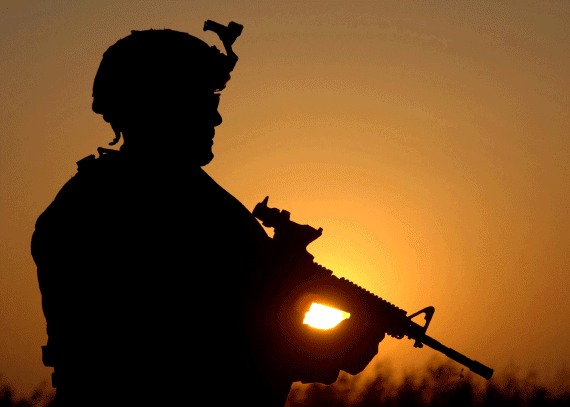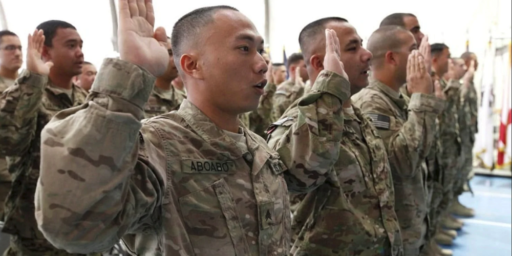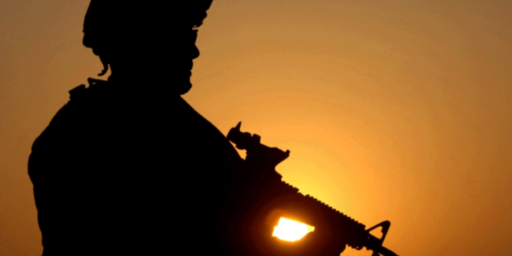Army: More Dangerous To Ourselves Than The Enemy
A review by the Army of its alarming spike in suicides blames it on the new strain of risk-seeking recruits who join during wartime and commanders who neglect to rein them in.
A review by the Army of its alarming spike in suicides blames it on the new strain of risk-seeking recruits who join during wartime and commanders who neglect to rein them in.
After nine years of war, the Army attracts recruits ready for combat but inclined toward risky personal behavior — a volatile mix that led to more deaths from suicide, drug overdoses and drinking and driving than from warfare, an Army review concludes.
“Simply stated, we are often more dangerous to ourselves than the enemy,” says the 15-month study, released Thursday.
Commanders have failed to identify and monitor soldiers prone to risk-taking behavior, the report says. As a result, suicides among soldiers have soared. “We lose track of some of those high-risk soldiers,” said Gen. Peter Chiarelli, the Army vice chief of staff. Many recruits join the Army knowing they will be sent to combat, so they may “even be more comfortable accepting high levels of risk and uncertainty in their lives,” the report says. That makes it more critical for commanders to enforce good order and discipline, according to the study.
Chiarelli commissioned the review 15 months ago as the Army suicide rate exceeded that for civilians. The study says poor command decisions helped contribute to a record 160 suicides by active-duty soldiers last year and an additional 146 deaths resulted from risky behavior such as drug or prescription medication abuse. Seventy-four of those deaths were overdoses. There were 1,713 attempted suicides last year.
Records show that last month, the Army averaged one suicide per day among either active-duty or National Guard soldiers and reserve troops. There were 32 confirmed or suspected cases.
In a few cases, the report says, commanders didn’t realize soldiers under their control had committed suicide until long after death occurred. “There are instances where a leader’s lack of soldier accountability resulted in suicide victims not being found until they had been dead for three or four weeks,” the report says.
Chiarelli said commanders allow infractions such as an arrest for drunken driving to go unpunished and don’t refer the soldier for possible alcohol abuse treatment. Often, he says, this might by done to allow a soldier to go to war. Since fighting in Afghanistan started in 2001, 25,283 soldiers who had committed violations that could have resulted in a discharge from the Army were allowed to remain in the service, the study shows. Many of these failures were an indirect result of the wars in Iraq and Afghanistan, the study says. Army efforts have become so concentrated on training and combat that routine oversight of soldiers has lapsed, the report says.
This strikes me as eminently plausible. During long periods of peace, men join the Army for secure employment, college benefits, travel, patriotism, and the like. But we’ve been at war for as long as new recruits can remember. That means people joining either want to fight or are so desperate for work that they’re willing to risk death. These are very different types of people.
While I served in combat, it was in a peacetime Army. That is, the expectation of those signing up was that they were unlikely to see action and, if they did, it would be of very short duration (Grenada, Panama, Desert Storm). And leaders aggressively counseled soldiers who were acting up, with very little tolerance before they were chaptered out of the service altogether.
My strong guess is that the mindset is different now. Things that were intolerable in my day are now just “boys being boys” and letting off some steam. With troops seeing two and three tours of combat duty, the thinking goes, they’ve earned the right. And, frankly, we need the manpower. Alcohol problem? Well, what better way to deal with that then send him off to Afghanistan, where there’s no alcohol! But, of course, the underlying problem remains — and is likely exacerbated both by the lack of the usual method of treatment (alcohol) and the strain of combat and separation from home and family.






***Things that were intolerable in my day are now just “boys being boys” and letting off some steam. ***
Working on Fort Leonard Wood I have observed this kind of behaviour and the acquiessence to it on a # of occasions. At some level I don’t think it is a bad idea… within limits.
It’s the stress of repeated tours of duty in a combat zone, especially if you are a trigger puller. We should have a law that forbids any soldier from being sent into combat more than once. For young soldiers knowing that they will be sent back over and over again is too much to ask. I know that in my case, after one tour in Vietnam, I would have retired rather than be sent back. Once is enough for anyone.
The trouble is that we don’t have enough men and women on active duty to prevent multiple tours. Bring back the draft, and soon.
I think it is also very plausible. Somebody who is looking for a certain training (one of the reasons my husband joined the Navy was because he wanted to participate in the nuclear power program and he wasn’t the only one in that program who joined for that reason) may not be so willing to look to the military for that training during war time. So the recruits are going to be people who are risk takers and willing to participate in a war or maybe even wanting to participate in war (sort of like people who want to jump out of airplanes or do other dangerous things for the adrenaline rush).
And honestly I can easily see during war time a commander being slower to handle certain behaviors or being more lenient with them than during peace time.
While I served in combat, it was in a peacetime Army.
And I also remember before that war (well the build up to the war really) all kinds of people being interviewed on TV saying things along the lines of “I didn’t join the Army to go to war, I joined the army to pay for school.” There were a few of those at the beginning of these wars, but pretty much anyone joining in the last few years was under no illusions that joining the military meant nothing more than free tuition and a few weekends a year. Joining any branch of the military likely means at least one trip to Iraq or Afghanistan.
Thanks for covering this James. It has been a dear subject to me ever since one of my men killed himself. I hope you saw Captain Hall’s guest post on Rick’s blog.
http://ricks.foreignpolicy.com/posts/2010/07/27/what_every_american_needs_to_know
I suspect there is some truth to this report, but think it more complex. These repeated deployments to this kind of asymmetrical war are unprecedented in US war. They just were not as common with the draftee military of Vietnam. Some people just break with this kind of repeated exposure. I also think that integrating back into civilian life has been tougher than expected. The animus towards troops in the 70s is not there, but employers seem to be looking fro skills guys are not bringing with them from the military. So, delayed suicides after getting out are a problem also. The approach to troops with PTSD and TBI is also still fragmented and inconsistent.
Steve
It looks like the suicide rate has been on a steady rise since the wars started which would be expected. However there was a sharper spike last year and an even sharper spike this year.
The arguments above about about it being due to recruits being more risk takers could explain at least in part the steady increase since the war started but doesn’t explain the sudden spike in the last two years. Unless someone can show a new policythat would explain a sudden increase in accepting a much larger number of risk takers in the last two years compare to prior, it doesn’t explain the sudden spikes.
Perhaps we should look at other possibilities. More troops in combat? I’m not sure but don’t think so. Change in public support? Possible. Feeling the mission is now a waste of time? Possible. Feeling a lack of support from higher? Possible. Maybe some other reason? Possible.
I am willing to look at many possibilities. Are you?